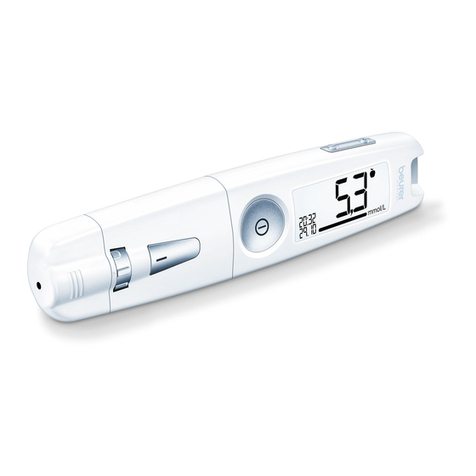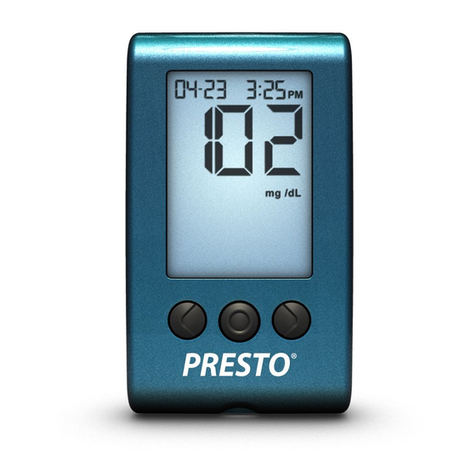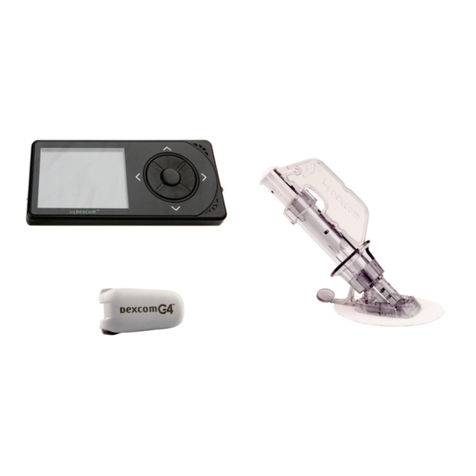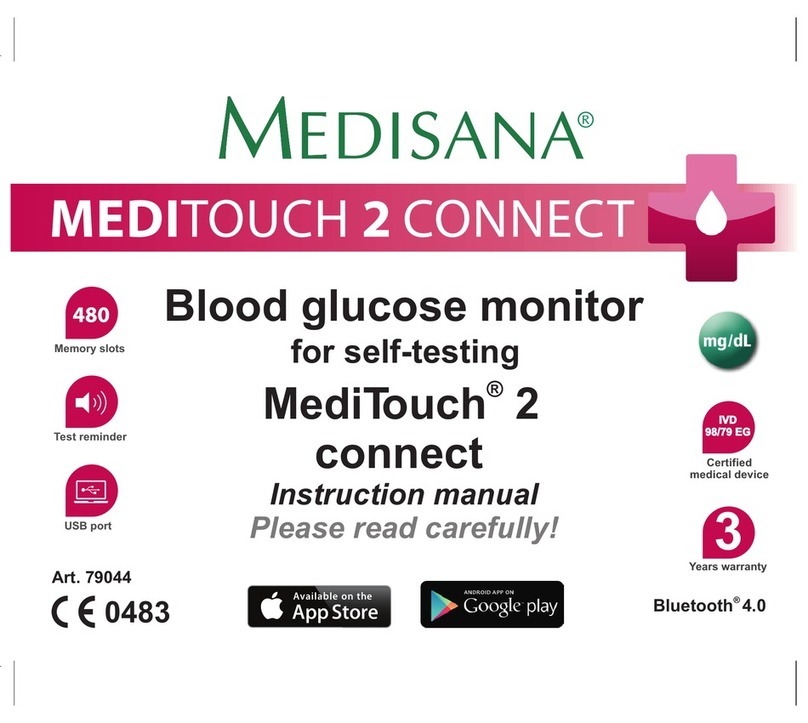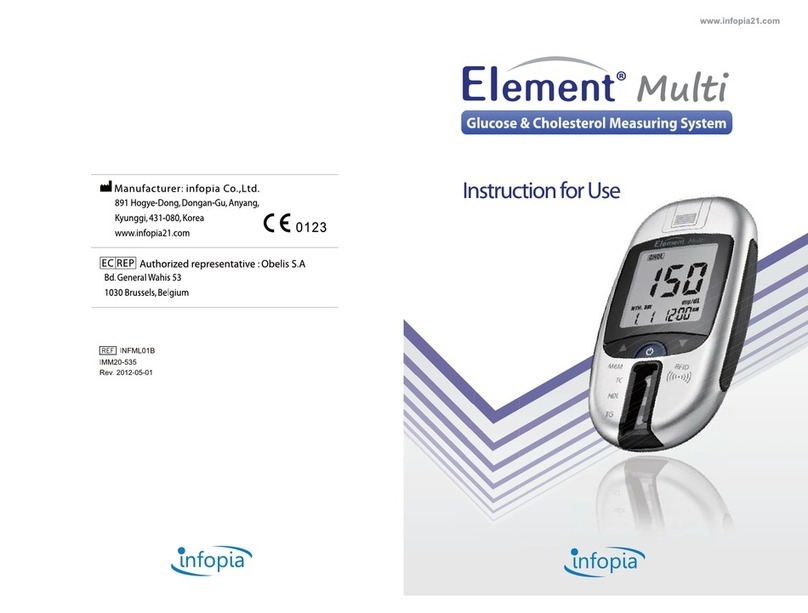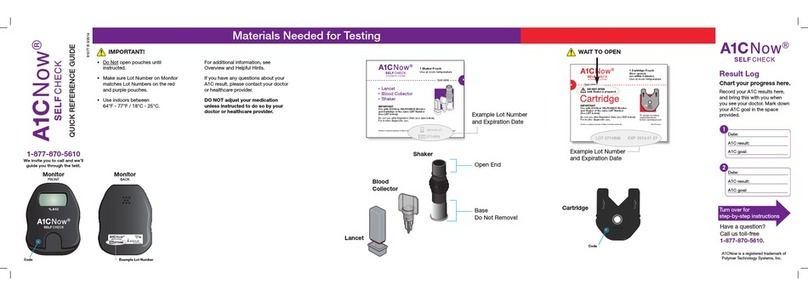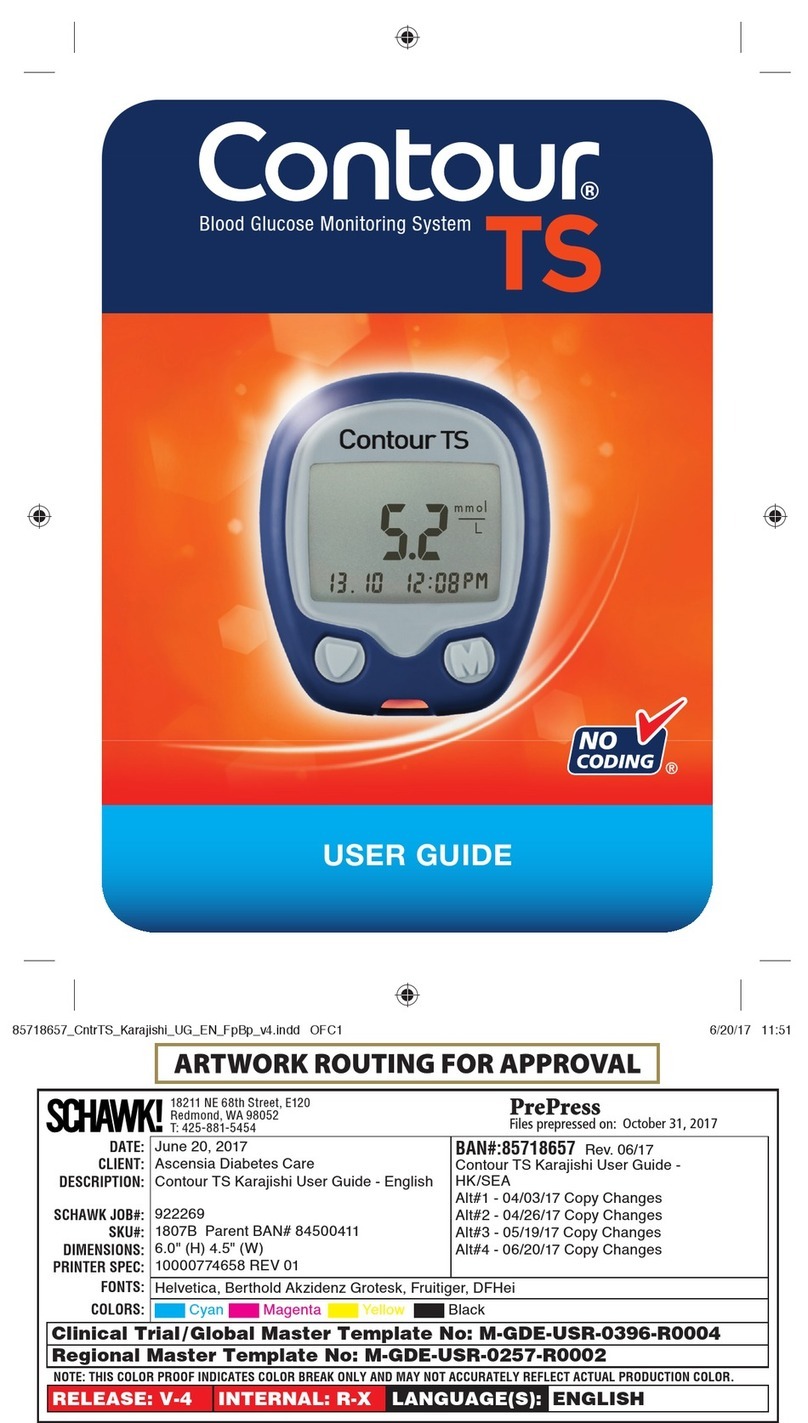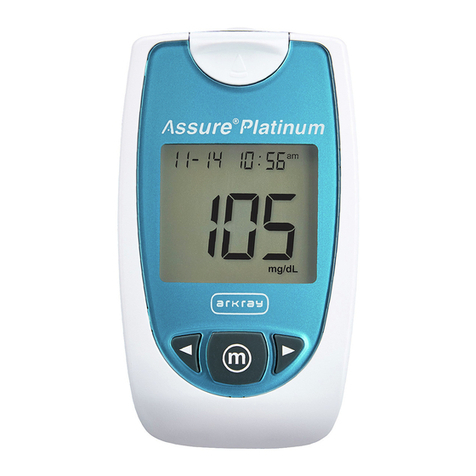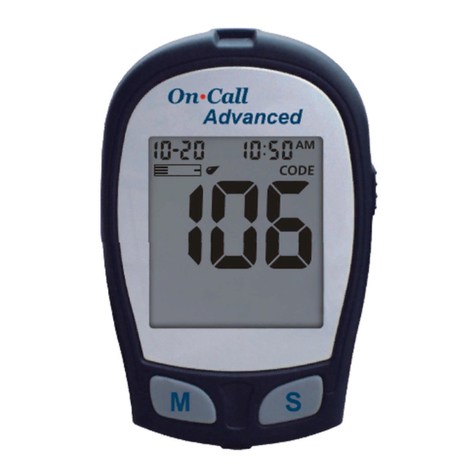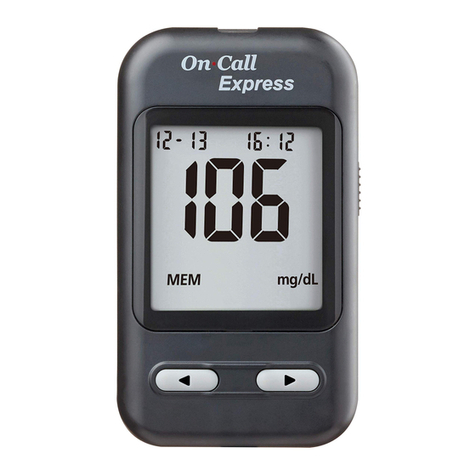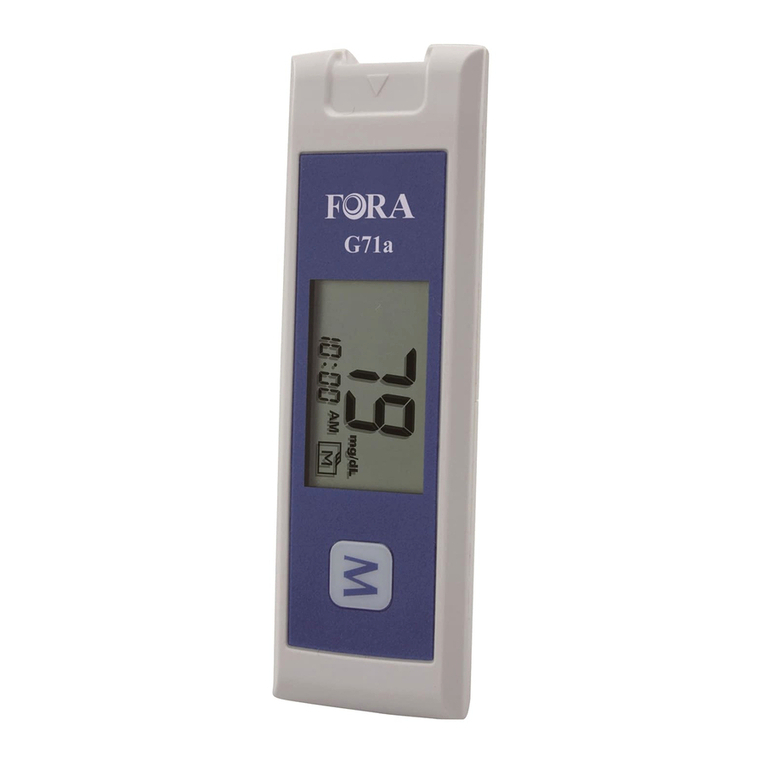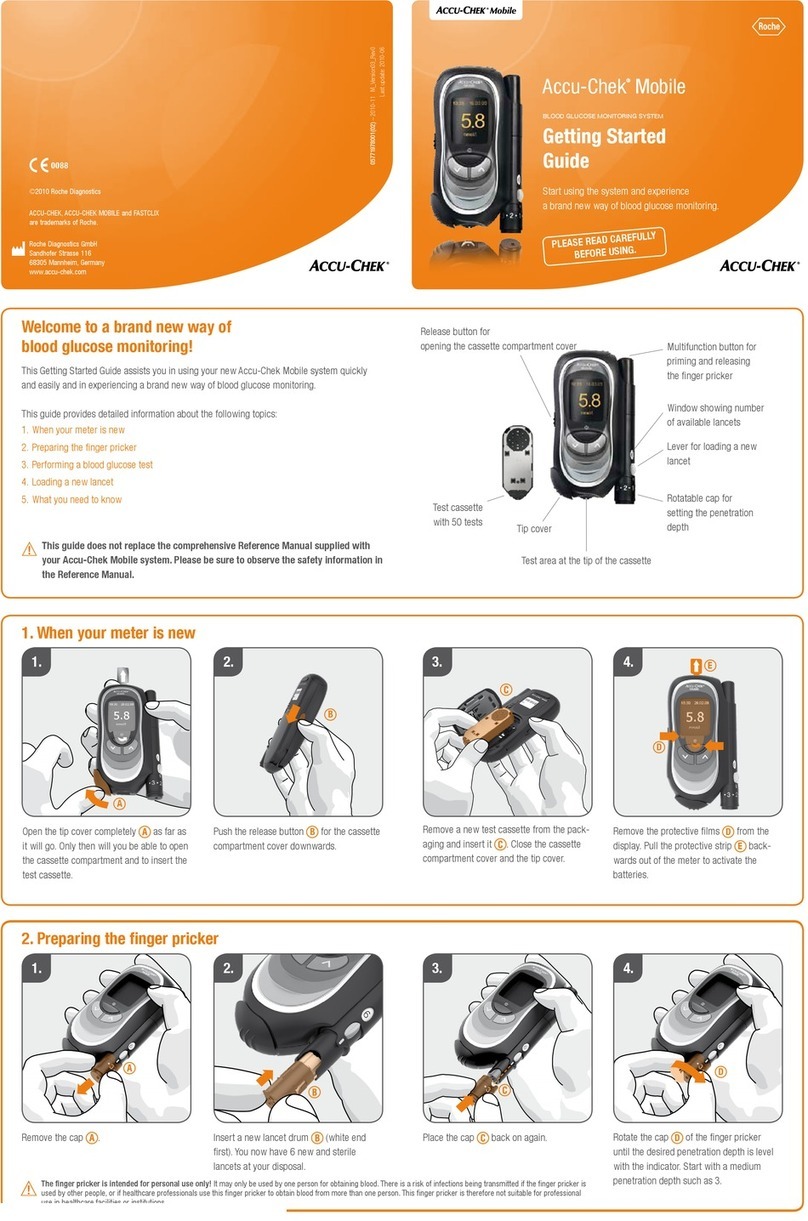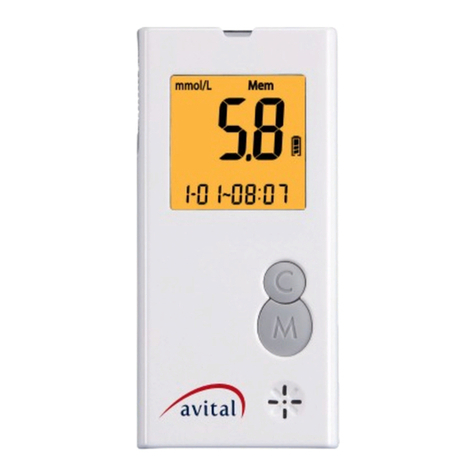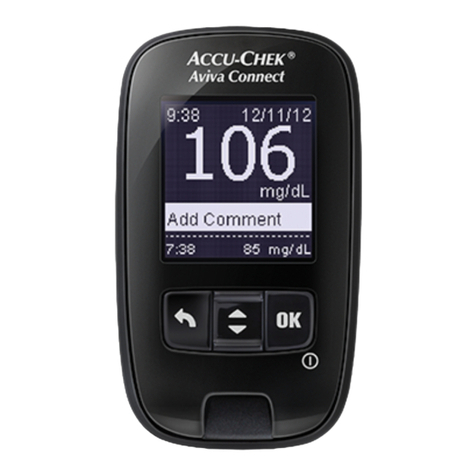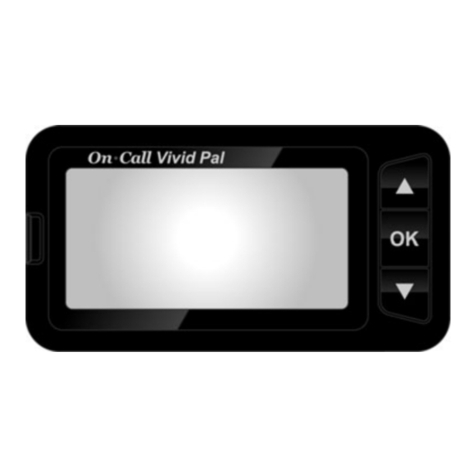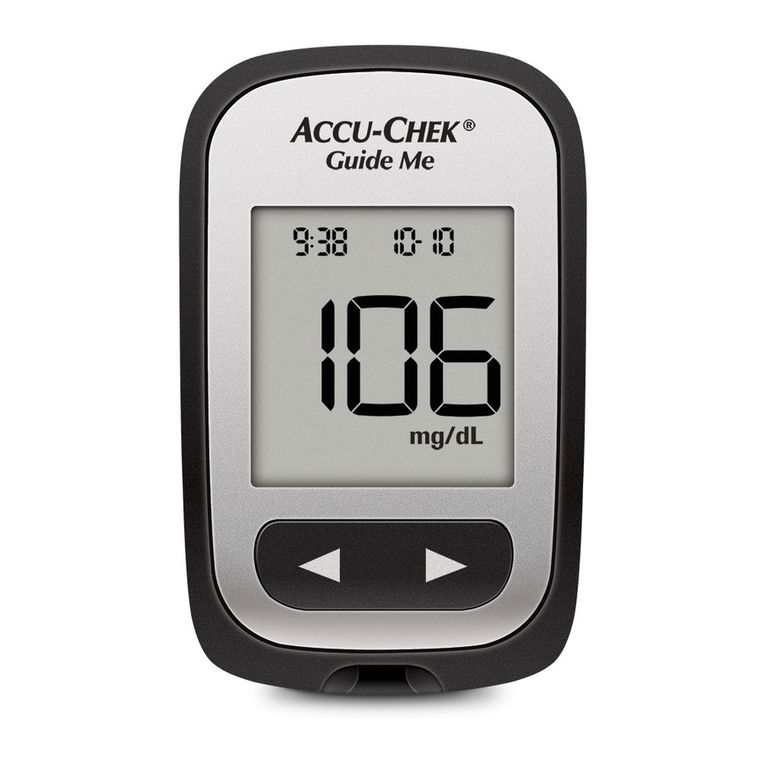gluco-comfort BGM 105 User manual

gluco-comfort
Blood glucose measuring systems
BGM 105 / BGM 205
Operating manual
Issued in 11/2006 REF: 590107

3
Contents:
1 Introduction 7
2 How to start up your gluco-comfort
blood glucose meter 11
2.1 Inserting/exchanging batteries 11
2.2 Switching on 13
2.3 Configuring the device 13
2.4 Setting the date and time 15
2.5 Setting the unit of measurement 17
2.6 Configuring the measured value
memory 18
2.7 Resetting the wireless connection 21
2.8 Clearing the measured value memory 23
3 Carrying out the blood glucose
measurement 24
3.1 Coding your meter 24
3.2 Preparing the measurement 25
3.3 Getting a drop of blood for the blood
glucose measurement 28
3.4 Carrying out the blood glucose
measurement 31
3.5 Use by multiple persons 35
4 Measured value memory 36
4.1 Storing the measured values 36
4.2 Calling the stored measured values 36
5 Function checks and caring for the
gluco-comfort blood glucose meter 39
5.1 Function control of the display 39
5.2 Reasons for a function check with
control solution 39
5.3
Carrying out the control measurement
39
5.4 Evaluating the control measurement 41
5.5 Maintaining and cleaning the device 42
5.6 Storage 42
5.7 Disposing of the meter 42
6 Error messages/causes of error
and measures to take 43
7 Technical data 49
8
Manufacturer warranty and guarantee
51
9 Symbols and abbreviations 52

4 5
Test strip
Display
Memory button:
1. Switch on device
(memory mode)
2. Selection button
(lower to higher value)
3. Select user
Set button
1. Switch on device (setting mode)
2. Selection button (next field)
3. Switch off device after the last
field has been set
On/Off button
1. Switch on device
(measuring mode)
2. Switch off device
3. Confirm user selec-
tion
Control elements
Sample capillary
1 Number field for: blood glucose measurement,
user no., year and code no.
2 “Blood drop” symbol: Prompt to apply blood to
the measuring field of the test strip
3 Number field for date
4 Battery symbol
− constant: weak battery
− blinking: dead battery
5 Number field for
− Year
− Time
− User activated / not activated
− Wireless connection activated / not activated
6 Symbol for active wireless connection (BGM 105)
7 Code no. indication when code chip inserted
day
avg
ctl
mem�
low
h
i
g
h
mg/dL
mmo
l
/
L
user
error
code
8 Error indication = error code
9 User no. indication
10 Indication of the set unit of measurement
(to be set in set mode)
11 Indication whether measured value too “high”
or too “low”
12 Indication of stored measurement
(= ”memory function”)
13 Indication of control solution measurement
(is not stored)
14 Days, e.g. 7, 14, 21, 28, from which the average
blood glucose values are to be calculated
15 Indication of average measurements
for 7, 14, 21, 28 days
1
2
3
4
5
6
7
8
9
10
11
12
13
14
15
Display elements
mem
biocomfort

6 7
1 Introduction
Dear User,
We are pleased that you have decided in
favour of the Biocomfort blood glucose
measuring system. It will be a reliable aid
for you in checking your blood glucose
values. The meter is easy to operate.
You can transfer the results to your PC
for further evaluation (model variant
BGM 105).
The Biocomfort blood glucose measuring
system is an in-vitro diagnostic device for the
quantitative blood glucose measurement in
capillary blood. It is meant for your personal
use at home, and therefore support you with
your diabetes therapy.
Safety information:
This operating manual contains important
information for you.
It is mandatory that the safety measures
mentioned in this operating manual be
taken.
The Biocomfort blood glucose measure-
ment system may only be used in the man-
ner described in this operating manual.
Please read the operating manual carefully
before using the device for the first time.
It is recommended that you take a practice
measurement. Keep your meter ready next
to you. Carry out every step immediately
after you have read it in the instructions.
All control elements and displays are
exactly explained. Keep the operating
manual in a safe place for future reference.
We recommend that you also instruct
other people in how to operate the
measuring system, in case you should
some day require help.
Introduction
1

8 9
and GCS305 are available separately as ac-
cessories.
Due to the wireless module in the gluco-com-
fort blood glucose meter BGM105, the use
of this device in certain secure areas, such as
intensive care stations or in airplanes, is not
allowed.
The original packaging of the gluco-comfort
blood glucose system with the wireless mod-
ule contains the following main components:
1. gluco-comfort meter BGM105
2. gluco-comfort test strips BGS105
3. gluco-comfort control solution GCS105
4. gluco-comfort lancing device LDV105
5. gluco-comfort lancets LCE105
The original packaging of the gluco-comfort
blood glucose system without the wireless
module contains the following main compo-
nents:
1. gluco-comfort meter BGM205
2. gluco-comfort test strips BGS105
3. gluco-comfort control solution GCS105
4. gluco-comfort lancing device LDV205
5. gluco-comfort lancets LCE105
In addition, further components are included:
– Battery
– Meter operating manual
– Package insert for test strips
– Package insert for control solution
– User instructions for the lancing device
– Meter short instructions
– Bag
Additional important information concern-
ing the test strips:
Please observe the separate user instructions
for the test strips.
– The test strips could be damaged by effects
of temperature and light. For this reason,
they should be used immediately after
being removed from the test strip con-
tainer.
– The test strips may not be used past the
expiration date. The test strips can be used
four months after the container has been
opened. When you open the container for
the first time, write down the date on the
container.
– Close the container carefully after remov-
ing the test strip. Always leave the contain-
er closed and keep it in a cool, dry place.
You can check your momentary blood
glucose level with high precision with the
Biocomfort blood glucose measuring system.
Only your doctor can determine whether
your blood glucose levels are an indication
of a diabetic illness requiring treatment,
however.
The Biocomfort blood glucose measuring
system includes many components, such as
test strips, the test strip container, batteries,
etc., which can be misplaced or can be
dangerous for children. For this reason, keep
your blood glucose measuring system out of
the reach of children. Also, make sure the
meter can’t be misused while in use.
If there are signs of damage or malfunctions,
the Biocomfort meter cannot be used.
Please use only the gluco-comfort test strips
BGS105 and gluco-comfort control solutions
GCS105, GCS205 or GCS305.
The gluco-comfort control solutions GCS 205
Introduction
1

10 11
2.1 Inserting/exchanging batteries
The Biocomfort blood glucose meter is de-
livered with a 3V lithium cell [type CR2032],
which must be inserted before taking the first
measurement.
If the battery symbol appears on the display,
this is an indication that the battery is already
weak and has to be exchanged soon. If the
battery symbol is blinking on the display, this
indicates that the battery must be exchanged.
A weak battery is to be exchanged so that er-
ror-free measuring results can be guaranteed.
When the battery is exchanged, all settings
which have been made on the device are
retained, as well as the stored measurements.
Insert battery
Important information regarding the
control solution:
Please observe the separate user instructions
for the control solution.
– Always shake the control solution well
before use.
– The control solution can be damaged if
exposed to heat. For this reason, you
should immediately seal the vial immedi-
ately after use and keep it in a cool place.
– The control solution may not be used
past the expiration date. Once the vial
is opened, it can be used for 3 months.
When you open it for the first time,
write down the date on the vial.
Getting started
2
2 How to start up your
gluco-comfort blood glucose
meter
+
CR�2032
gluco-comfort
Modell:�BGM105
REF:�590020��SN:�0526002A�
�IVD�zur�Eigenanwendung
zur�ausschließlichen�Verwendung�mit�
Teststreifen�REF�BGS105��
������������r.F.:20%�-�85%�Batt.:�CR-2032�3V
Biocomfort�Diagnostics�GmbH�&�Co.�KG
Bernhäuser�Straße�17
D�73765�Neuhausen�a.�d.�Fildern
biocomfort
0197
10ºC 40ºC
+
CR�2032

12 13
Attention:
For the sake of the environment: Used batter-
ies belong in the hazardous waste!
2.2 Switching on
Switch on your blood glucose meter by press-
ing the On/Off button.
Every time you turn it on, all display elements
appear for about two seconds as a function
test. Please make sure that the display
elements can really be seen completely, as
shown in the figure on page 5. A defective
display can show false values in later meas-
urements.
Note:
– If no test strip is inserted into the meter or
if no button is pushed within 2 minutes,
the blood glucose meter switches off auto-
matically.
– If a test strip is inserted without any blood
or control solution on the application field,
Please follow the following steps for
inserting/exchanging the battery:
Step 1:
Please always switch off the device before
exchanging the battery.
Step 2:
Pull the battery compartment cover (on the
back side of the device) in the direction of
the arrow and remove.
Step 3:
Remove any used battery.
Step 4:
Insert the 3V lithium cell with the writing
facing up.
Step 5:
Replace the battery compartment cover and
push it over the compartment until you hear
the cover click into place.
Step 6:
Afterwards, check whether the battery has been
correctly inserted by briefly pressing the On/Off
button. In this case, all elements of the display ap-
pear for about two seconds as a function check.
Note:
– Please make sure that you always have a
replacement battery on hand.
– A new battery (3V lithium cell) has a life-
time of about three months (BGM105) or
for around 800 measurements (BGM205).
– When the batteries are exchanged and
when the meter is stored without batter-
ies, the contents of the measured value
memory are retained.
– When battery is removed, the internal
clock of the measuring device doesn’t
continue to run, so when the device is
used again after exchanging the batteries
or after storing the device without batter-
ies, the date and time may have to be reset
(see Section 2.4).
the meter switches off automatically after
about six minutes.
2.3 Configuring the device
Before the blood glucose meter is used for
the first time or when adapting the meter to
your needs, you must make a few settings
in the settings menu. To do this, you will
press the SET, MEM and On/Off buttons,
as described in the following sections.
The SET button can be found underneath
the On/Off and MEM buttons. It is covered
by these two buttons to avoid pressing it by
mistake. It’s easiest to press the SET button
with a small, flat object (e.g. paperclip)
(see figure on page 14).
Getting started
2

14 15
Step 2:
As soon as the year starts blinking on the
display, keep pressing the MEM button until
the correct year appears.
While you are in the settings menu, the
buttons have the following functions:
SET button:
If you press the SET button with the meter
switched off, you will get into the settings
menu. The year of the date is the first setting
which can be made. You can tell which
parameter can be set at any given time by its
blinking. If you press SET again, you proceed
to the next settable parameter.
MEM button:
By pressing the MEM button, you can change
the currently blinking parameter until it takes
on a value you desire. Now you can go to the
next parameter by pressing the SET button,
or you can exit the settings menu by pressing
the On/Off button.
Note:
If you keep the MEM button pressed, you can
change the active parameter faster.
Pressing the SET button
On/Off button:
By pressing the On/Off button, you exit the
settings menu and the set parameters are
saved.
2.4 Setting the date and time
Note:
The measured blood glucose values are
stored with the date and time. The correct
setting of the date and time makes it easier
for you to make a correct time allocation of
your measurements.
In order to set the correct date and time on
your measuring device, proceed as follows:
Step 1:
With the device switched off, first press
the SET button with a small, flat object
(e.g. paper clip).
gluco-comfort
biocomfort
mem
Getting started
2

16 17
Step 3:
When you press the SET button again, you
activate the month display.
Step 4:
Keep pressing the MEM button until the cor-
rect month is displayed.
Step 5:
By pressing the SET button again, you acti-
vate the day display.
Step 6:
Keep pressing the MEM button until the cor-
rect day is displayed.
Step 7:
By pressing the SET button again, you acti-
vate the hour display.
Step 8:
Keep pressing the MEM button until the cor-
rect hour is displayed.
Step 9:
By pressing the SET button again, you acti-
vate the minute display.
Step 10:
Keep pressing the MEM button until the cor-
rect minute is displayed.
Step 11:
If you are finished making settings, you can
exit the settings menu by pressing the On/Off
button. Otherwise, continue making settings
by pressing the SET button.
2.5 Setting the unit of measurement
Note:
The blood glucose values can either be
displayed in mg/dl or in mmol/l. The setting
of the unit of measurement can be found in
the settings menu sequence after the date
and time.
Step 1:
To change the unit of measurement, press the
SET button until the set unit of measurement
starts blinking on the display (see figure on
page 18, blinking unit of measurement).
Getting started
2

18 19
Step 2:
In order to select the other unit of measure-
ment, press the MEM button.
Step 3:
If you are finished making settings, you can
exit the settings menu by pressing the On/Off
button. Otherwise, continue making settings
by pressing the SET button.
2.6 Configuring the measured value
memory
Note:
The blood glucose meter stores the measured
blood glucose values. The measured value
memory can be configured so that the
measurements can be allocated to eight
different users.
To do this, the measured value memory must
be enabled for the individual users.
2.6.1 Configuration of the model variant
BGM205
In its delivered condition, the measured
value memory is only enabled for one user
(“User 1”).
The configuration of the measured value
memory can be found after the unit of
measurement setting in the settings menu
sequence.
Step 1:
To enable (or block) several measured value
memories, press the SET button until the
word “user” appears on the display in the up-
per right-hand corner (see figure), and to the
left of the word “user”, the number “1” ap-
pears. In the lower area of the display, either
the word “on” or “off” is blinking in addition.
This indicates whether the measured value
memory for user 1 is enabled or blocked at
this time.
mem
gluco-comfort
biocomfort
user
mem
gluco-comfort
biocomfort
mg/dL
mmo
l
/
L
Getting started
2

20 21
Note:
If measured value memories are enabled
for several users, each user must know his
or her own identity number. Before each
measurement, it must be made sure that
the correct user identity number has been
selected (see Section 3.2, steps 3 to 5).
The procedure for clearing the measured
value memory is described in Section 2.8.
2.6.2 Configuration of the model variant
BGM105
The model variant BGM105 is used together
with the Health Manager software and is con-
figured using the Health Manager on your PC
or PDA.
Due to data synchronisation, at least one user
must be enabled in the software on the PC or
PDA before the blood glucose meter can be
activated.
“on” means:
The measured value memory is enabled for
user 1.
“off” means:
The measured value memory is blocked for
user 1.
Step 2:
To change the measured value memory state
for user 1 from “off” to “on” or vice versa,
press the MEM button.
Step 3:
After you have set the measured value mem-
ory to the status you wish, you can set the
status for user 2 by pressing the SET button.
Remark:
If, for example, you want to change the meas-
ured value memory status for user 5, press
the SET button until the number “5” appears
to the left of the word “user” and carry out
step 2.
Step 4:
If you are finished making settings, you can
exit the settings menu by pressing the On/Off
button. Otherwise, continue making settings
by pressing the SET button.
2.7 Resetting the wireless connection (only
applies for the model variant BGM105)
Note:
The model variant BGM105 is equipped with
a wireless interface. With this, you can wire-
lessly transfer the measured blood glucose
measurements to a PC which is equipped
with a Biocomfort wireless module (USB 105)
or to a PDA (equipped with wireless module
CFC 105) for further processing (e.g. statisti-
cal evaluation) or archiving.
This setting should only be made when it’s
no longer possible to reset with the Health
Manager.
Details can be found in the software instruc-
tions.
The configuration of the wireless interface
can be found after the configuration of the
unit of measurement setting in the settings
menu sequence.
user
user
user
Getting started
2

22 23
Step 1:
To reset the wireless interface, keep pressing
the SET button until the radio symbol at the
bottom left of the display (= fat black dot in
double-parentheses ) starts to blink. To the
right of the radio symbol appear two “0”s.
If there is no dash between the two “0”s, this
means that the wireless connection is reset.
If there is a dash between the two “0”s, this
means that the wireless connection is main-
tained.
Step 2:
To switch between maintaining and reset-
ting the wireless connection, press the MEM
button.
Step 3:
If you are finished making settings, you can
exit the settings menu by pressing the On/Off
button. Otherwise, continue making settings
by pressing the SET button.
2.8 Clearing the measured value memory
The operation for clearing the measured
value memory is the last item in the settings
menu.
Step 1:
In order to clear the stored blood glucose val-
ues from the measured value memory, press
the SET button until the word “mem” starts
blinking on the right side of the display.
Step 2:
When you press the MEM button, “CLr”
(clear) appears at the bottom of the display
(means that the memory will be cleared).
Remark:
When the abbreviation “CLr” appears on the
display and you switch off the device via the
On/Off button or by pressing the SET button,
the entire measured value memory is cleared.
If you do not wish to clear the values, press
the MEM button again to make “CLr” disap-
pear.
mem�
mem�
Getting started
2

24 25
3.1 Coding your meter
Attention:
In order to get correct blood glucose meas-
urements, the meter has to be coded for the
used test strips.
Every time you make a measurement, check
whether the code number on the display of
the meter and the code number on the test
strip package are identical.
If the code numbers on the meter display
and on the label of the test strip package are
not identical, the device must be (re-)coded.
Coding is required before the the meter is
used for the first time in any case, as well as
when test strips of another code number are
used.
3.2 Preparing the measurement
To carry out a blood glucose measurement,
have the following listed utensils ready:
– The gluco-comfort blood glucose meter
BGM105 or BGM205
– one gluco-comfort test strip, BGS105
– The gluco-comfort lancing device LDV105
or LDV205
– one gluco-comfort lancet LCE105
– Clean paper towel or clean paper tissue
Prepare for your blood glucose
measurement as follows:
Step 1:
Wash your hands thoroughly with warm
water and soap.
Step 1:
With the meter switched off, insert the code
chip (included in the test strip package) into
the test strip receptacle of the meter until it
clicks into place. When doing so, the curved
side of the code chip must be facing up.
The information contained on the code chip
is stored together with the code number in
the meter.
Step 2:
As soon as the code number of the code
chip appears on the meter display, you can
remove the code chip from the test strip
receptacle.
Note:
Keep the code chip in the test strip pack-
age until all test strips have been used up.
Afterwards, you can dispose of the code chip
along with the empty test strip package in
your household garbage.
3 Carrying out the blood glucose
measurement
Carrying out the blood glucose measurement
3
biocomfort
0197
Code�1342
Stück�25
����Jan�2006
����������
04L09-B02����������
LOT
kermessgerät�gluco-comfort�BGM105�verwenden!
Behälter�wie��er�fest�verschließen!
age�nach�Anbruch�z�verwenden.
Code�1213
biocomfo
mem
gluco-comfort
biocomfort
code
code
1362

26 27
mem
gluco-comfort
biocomfort
code
user
user
Step 2:
Remove one test strip from the package.
Make sure that you close the package imme-
diately after removing the strip.
Note:
Please observe the separate user instructions
for the test strips.
Step 3:
With the device switched off, guide the test
strip with the darker side facing up into the
test strip receptacle in the direction of the ar-
row until you feel it click into place.
Step 4:
If the test strip is positioned correctly, the
device switches on automatically.
Step 5:
The user identity number of the measured
value memory where the result of the last
blood glucose measurement was stored
blinks on the display (see Section 3.5
“Use by multiple persons”).
Step 6:
If the user identity number doesn’t agree
with your measured value memory, press the
MEM button until the identity number of your
measured value memory appears.
Step 7:
Confirm the measured value memory selec-
tion by pressing the On/Off button.
The meter acknowledges this with a beep.
Step 8:
In the top part of the display, the last stored
test strip code number appears, and in the
bottom part, the test strip symbol.
mem
gluco-comfort
biocomfort
user
mem�
code
code
Carrying out the blood glucose measurement
3

28 29
Step 1:
Remove the cap of the lancing device.
Step 2:
Insert a new lancet in the lancing device.
3.3 Getting a drop of blood for the blood
glucose measurement
Using the gluco-comfort lancing device
LDV105/LDV205 allows you to get a blood
sample gently, with almost no pain, and
hygienically.
Attention:
To avoid infections, use a new lancet for
every lancing.
When the skin is lanced, the finely ground
surface of the lancet dulls, which makes it
potentially painful to use a used lancet.
Note:
You can also start the meter by pressing the
On/Off button without inserting a test strip in
the test strip receptacle. Steps 3 - 6 are car-
ried out the same way as described before.
As opposed to the first way with the inserted
test strip, the test strip symbol on the display,
as described under Step 7, blinks as a prompt
to the user to insert the test strip now.
Step 9:
After the test strip has been properly posi-
tioned, the meter signals that it is ready for
measuring with two short beeps. In addition,
a drop symbol blinks on the display.
Step 3:
Remove the protective cap from the lance by
turning and pulling it off.
Step 4:
Replace the cap of the lancing device and
set it to the desired lancing depth (see figure
on page 30).
Carrying out the blood glucose measurement
3

30 31
lower lancing depth higher lancing depth
Remark:
The required lancing depth is different from
person to person. In principle, it is to be as-
sumed that you will get a larger drop of blood
with a high lancing depth than you would
with a low lancing depth. You can define the
right lancing depth for you based on your
experience.
Step 8:
Hold the lancing device to the side of the
finger pad and press the release button.
Step 9:
Carefully press on the finger pad until a blood
drop is formed.
3.4 Carrying out the blood glucose
measurement
Step 1:
Hold the drop of blood next to the right
side of the test strip. As soon as the blood
drop touches the “nose” in the middle of the
notch, the blood is drawn in by the measur-
ing cell.
Step 5:
Allow your arm to hang down relaxed so that
blood can flow into your fingertips.
Step 6:
Massage the finger from which you’d like to
get your sample for about three seconds
(don’t squeeze) to increase the blood flow.
Step 7:
Wind up the lancing device.
Carrying out the blood glucose measurement
3

32 33
Note:
The measuring cell of an unused test strip
is transparent. After a sufficient amount of
blood has been drawn in, the measuring cell
is filled completely with blood.
The measuring cell of the test strip can only
be filled at the “nose”, mentioned above.
Wetting at other places on the test strip won’t
lead to a correct measurement.
Step 2:
Once the measuring cell of the test strip
is sufficiently filled with blood, the meter
confirms this with a beep. The measurement
starts automatically.
Step 3:
The blood glucose measurement takes ten
seconds. There is a measuring time “count-
down” on the display.
Step 4:
The end of measurement is confirmed
with two short beeps. The measured blood
glucose value is displayed with the date and
time of the measurement. This data is stored
in the measured value memory of the user.
Attention:
Hyperglycaemia warning
(blood glucose level too high):
If the result of your blood glucose measure-
ment is above a level of 160 mg/dl
(or 8.8 mmol/l), the word “high” appears
on the right next to the blood glucose value.
This is a warning that your blood glucose
level is too high.
Hypoglycaemia warning
(blood glucose level too low):
If the result of your blood glucose measure-
ment is above a level of 50 mg/dl
(or 2.78 mmol/l), the word “low” appears
on the right next to the blood glucose value.
This is a warning that your blood glucose
level is too low.
mem
gluco-comfort
biocomfort
mem
mem
gluco-comfort
biocomfort
mem
mem
gluco-comfort
biocomfort
mem
Carrying out the blood glucose measurement
3

34 35
Attention:
– If such extreme values don’t correspond
with the way you feel, repeat the measure-
ment to confirm the result.
– If the measurements don’t change, see
your doctor immediately!
– If you should feel symptoms which don’t
agree with your measured blood glucose
values, never change your medicine dos-
age without previously consulting your
physician.
The blood glucose measurement can lead to
false results:
– when the haematocrit value of the patient
is less than 20% or greater than 60%.
– in patients with haemolytic blood
– in patients who have icterus (jaundice)
– in patients who have lip(id)aemia
– when there is a change in the peripheral
blood circulation
– when coagulated blood is measured
– when the time span from getting the blood
drop to measurement is too long.
Your doctor can clarify whether your meas-
urements are influenced by one of these
cases.
Notes:
Take the test strip out of the meter after the
measurement.
Properly dispose of used test strips and lan-
cets immediately after measurement so that
they cannot injure/infect anyone.
3.5 Use by multiple persons
When the blood glucose meter is shared by
several persons, the measured value memory
can be configured so that the measured
blood glucose measurements can be allo-
cated to up to eight different users based on
the user identity number (1 to 8).
For the correct allocation of the respective
measurements to a measured value memory,
the user is prompted during the course of the
measurement to confirm the user identity
number displayed by the device or to select
the correct user identity number (see Section
3.2, steps 5 to 7).
Attention:
To avoid infections, if the meter is used by
several persons, make sure that the meter is
not contaminated with blood. Contaminated
blood glucose meters are to be cleaned
before further use and are to be disinfected, if
necessary.
To avoid infections, each user must use his or
her own lancing device.
Carrying out the blood glucose measurement
3

36 37
4.1 Storing the measured values
The Biocomfort blood glucose meter auto-
matically saves the last 122 measured blood
glucose measurements together with the date
and time of measurement.
If the memory is full, the oldest result is
overwritten by the result of the next measure-
ment.
The measured values are retained in the
measured value memory even when the
battery is removed.
4.2 Calling up the stored measured values
For every user identity number, the stored
blood glucose measurements can be called
up, from the last one to the oldest one. In ad-
dition, the average blood glucose values for 7,
14, 21 and 28 days can be displayed.
To display the memory contents, proceed as
follows:
Step 1:
Press the MEM button to access the meas-
ured value memory. The device is now
switched on.
Step 2:
The user identity number blinks on the dis-
play in whose measured value memory the
result of the last blood glucose measurement
was stored (see Section 3.5 “Use by multiple
persons”).
Step 3:
In order to look at the contents of the
measured value memory of a certain user,
press the MEM button until the desired user
identity number appears.
Step 4:
Confirm the selection by pressing the On/Off
button.
Step 5:
The last stored measurement for the selected
user appears on the display with date and
time.
Step 6:
When you press the MEM button again,
the average value the meter calculated
for the last seven days is displayed.
Here, the number of days selected for the
average value is shown to the left of the
word “day”. To the left next to the abbrevia-
tion “avg” (average), the number of meas-
urements appears which were taken into
account in the calculation of the average
value.
Step 7:
After pressing the MEM button again, the
average value of the measurements of the
last 14 days is displayed. Here, the number
14 is displayed to the left of the word “day”
(see figure on page 38).
mem�
mg/dL
mem�
mg/dL
Measured value memory
4
4 Measured value memory
day
avg
mem�
mg/dL

38 39
5.1 Function control of the display
Every time you turn on the blood glucose
meter, all display elements appear for about
two seconds. This allows you to see whether
all display elements are working properly.
5.2 Reasons for a function check with
control solution
We recommend a check be carried out with
a control solution:
– at least once a week
– for practicing before your first blood
glucose measurement with the
Biocomfort blood glucose meter
– after opening a new package
of test strips
Note:
To quickly scroll through the results, press the
MEM button and hold.
Remark:
By repeatedly pressing the MEM button, the
average values of the last 21 and then 28 days
are displayed. Afterwards, all stored individu-
al values can be viewed, from the second-to-
last one to the oldest available measurement.
Step 8:
To exit memory mode, switch the device off
again with the On/Off button.
Once the end of the measured value memory
has been reached, or if there are no other
measured values available, the following is
displayed:
– when you think that the meter or test strips
aren’t functioning properly
– when your blood glucose results don’t
agree with your subjective feeling of well
being
5.3 Carrying out the control measurement
The blood glucose meter function check is
carried out in the same way as a normal
blood glucose measurement except the
measuring cell of the test strip is filled with
gluco-comfort control solution instead of
with blood.
To do this, put a drop of control solution on
one of your fingernails and then bring the
drop in contact with the measuring cell of
the test strip.
To carry out the blood glucose measurement,
see Section 3.4.
5 Function checks and caring
for the gluco-comfort blood
glucose meter
day
avg
mem�
mg/dL
Function check and care
5
mem�
mem�
This manual suits for next models
1
Table of contents
